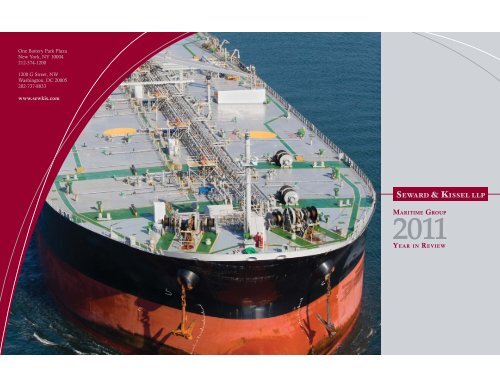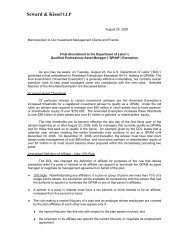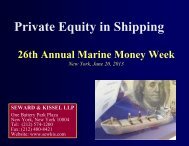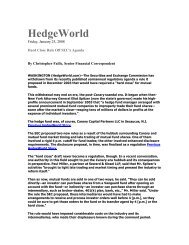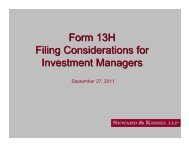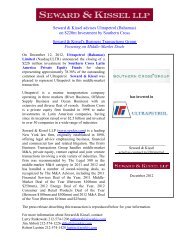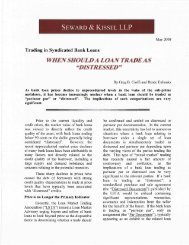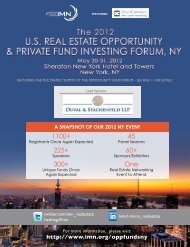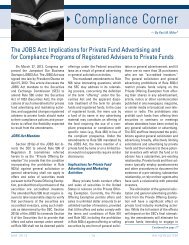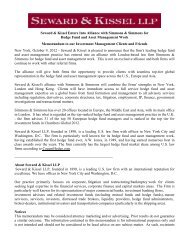Maritime Group 2011 Year in Review - Seward and Kissel
Maritime Group 2011 Year in Review - Seward and Kissel
Maritime Group 2011 Year in Review - Seward and Kissel
- No tags were found...
You also want an ePaper? Increase the reach of your titles
YUMPU automatically turns print PDFs into web optimized ePapers that Google loves.
One Battery Park PlazaNew York, NY 10004212-574-12001200 G Street, NWWash<strong>in</strong>gton, DC 20005202-737-8833www.sewkis.comSEWARD & KISSEL LLPMARITIME GROUP<strong>2011</strong>YEAR IN REVIEWSEWARD & KISSEL LLPwww.sewkis.comSEWARD & KISSEL LLPwww.sewkis.com
To Our Friends <strong>and</strong> ClientsThe <strong>Maritime</strong> Industry saw many changes <strong>in</strong> <strong>2011</strong>. The full impact ofthose changes may not be known for years to come, but one th<strong>in</strong>g iscerta<strong>in</strong>: the <strong>Maritime</strong> Industry as we know it will never be the same.through these tumultuous times. Our unique <strong>in</strong>sight <strong>and</strong>capabilities have been honed through decades of experience <strong>in</strong>both good <strong>and</strong> bad markets. We have been <strong>in</strong>volved <strong>in</strong> all facets ofthe U.S. <strong>Maritime</strong> Industry <strong>in</strong>clud<strong>in</strong>g ship f<strong>in</strong>ance, public offer<strong>in</strong>gsSome of the changes raise questions that will only be answered withthe passage of time. For <strong>in</strong>stance, will the decision of the BankruptcyCourt <strong>in</strong> Marco Polo o Seatrade ade B.V. open the floodgates for United<strong>and</strong> private placements, private equity <strong>in</strong>vestments, purchases<strong>and</strong> sales, <strong>and</strong> mergers <strong>and</strong> acquisitions, <strong>and</strong> have acted <strong>in</strong> variedcapacities <strong>in</strong> each of these types of transactions.States bankruptcy fil<strong>in</strong>gs of foreign shipp<strong>in</strong>g companies with onlytenuous connections to the United States? Will the lend<strong>in</strong>g w<strong>in</strong>dowthat seemed to be open<strong>in</strong>g <strong>in</strong> early <strong>2011</strong>, <strong>and</strong> that was slammedshut aga<strong>in</strong> dur<strong>in</strong>g the summer, reopen? If so, who will be lend<strong>in</strong>g toshipp<strong>in</strong>g companies <strong>and</strong> on what terms? What role will private equityplay <strong>in</strong> the <strong>Maritime</strong> Industry go<strong>in</strong>g forward? Will private equity be thesource of fund<strong>in</strong>g to keep shipp<strong>in</strong>g companies alive or will it be thereto pick up the pieces if the bottom truly falls out? How will the SEC’snew rules relat<strong>in</strong>g to foreign issuers impact shipp<strong>in</strong>g companies’access to the United States capital markets <strong>and</strong> will Dodd-Frank’ ’s “Say<strong>Seward</strong> & <strong>Kissel</strong> LLP is the <strong>in</strong>dustry leader among U.S. law firms <strong>in</strong>the shipp<strong>in</strong>g arena. Our attorneys are experienced <strong>in</strong> h<strong>and</strong>l<strong>in</strong>g thetransactions <strong>and</strong> the issues that arise when the shipp<strong>in</strong>g marketsexp<strong>and</strong> <strong>and</strong> when they contract. From the restructur<strong>in</strong>gs <strong>and</strong>bankruptcies of the 1980s, through the boom <strong>and</strong> bust of the highyield market <strong>in</strong> the late 1990s <strong>and</strong> early 2000s; from the flourish<strong>in</strong>gloan <strong>and</strong> public offer<strong>in</strong>g markets <strong>in</strong> the mid-2000s, to the mostrecent foreclosures, restructur<strong>in</strong>gs <strong>and</strong> <strong>in</strong>solvencies, <strong>Seward</strong> &<strong>Kissel</strong> attorneys have been <strong>in</strong>volved every step of the way.on Pay” <strong>and</strong> “Claw Back” provisions have a cool<strong>in</strong>g effect on privateshipowners’ desire to go public <strong>in</strong> the United States?We are pleased to provide guidance to our clients <strong>in</strong> these difficulttimes <strong>and</strong> look forward to cont<strong>in</strong>u<strong>in</strong>g to assist our clients as theThe questions are endless <strong>and</strong> the answers uncerta<strong>in</strong>, but whateverthe outcome, <strong>Seward</strong> & <strong>Kissel</strong> will be there to help guide its clients<strong>Maritime</strong> Industry f<strong>in</strong>ds its bear<strong>in</strong>g <strong>and</strong> charts the course for 2012<strong>and</strong> beyond.<strong>Seward</strong> & <strong>Kissel</strong> LLP1SEWARD & KISSEL LLPwww.sewkis.comSEWARD & KISSEL LLPwww.sewkis.com
New York Bankrupcy Court setsLow Bar for Chapter 11 Eligibility forForeign Shipp<strong>in</strong>g CompaniesOn October 21, <strong>2011</strong>, the U.S. Bankruptcy Court <strong>in</strong> New York rendereda key decision <strong>in</strong> the bankruptcy cases of Marco Polo Seatrade B.V.(“Marco Polo”) <strong>and</strong> its affiliated debtors (collectively the “Debtors”)determ<strong>in</strong><strong>in</strong>g that entities with few <strong>and</strong> m<strong>in</strong>imal ties to the UnitedStates are eligible to be Chapter 11 debtors. In its bench decision,the Court found that a cash reta<strong>in</strong>er paid to the Debtors’ New Yorklawyer which rema<strong>in</strong>ed <strong>in</strong> escrow, <strong>and</strong> one Debtor’s <strong>in</strong>terest <strong>in</strong> a U.S.shipp<strong>in</strong>g pool account, each constituted “property” of the Debtors<strong>in</strong> the United States, satisfy<strong>in</strong>g the Chapter 11 debtor eligibilityrequirements. That the Debtors were all Dutch entities with no placeof bus<strong>in</strong>ess or employees <strong>in</strong> the United States did not alter the U.S.Bankruptcy Code’s “relatively low bar” for “property sufficient toestablish [Chapter 11] eligibility”.The decision <strong>in</strong> Marco Polo will be encourag<strong>in</strong>g to other foreigndebtors with limited connections to the United States who wish toseek Chapter 11 relief <strong>and</strong> the protections available under the U.S.Bankruptcy Code, <strong>in</strong>clud<strong>in</strong>g the automatic stay. The automatic stay,which on its face has global reach, <strong>in</strong> theory, may be particularlybeneficial to foreign shipp<strong>in</strong>g companies who have an <strong>in</strong>ternationalbus<strong>in</strong>ess with assets (<strong>and</strong> creditors that can reach those assets)located around the world. Indeed, foreign shipp<strong>in</strong>g companies withseparate vessel own<strong>in</strong>g companies may f<strong>in</strong>d Chapter 11 especiallyuseful to thwart enforcement actions taken by lenders <strong>and</strong> certa<strong>in</strong>other creditors aga<strong>in</strong>st the vessels <strong>in</strong> several different forums.On the other h<strong>and</strong>, the effectiveness of the automatic stay <strong>in</strong>prevent<strong>in</strong>g foreign creditors without a U.S. presence from seiz<strong>in</strong>gassets abroad rema<strong>in</strong>s questionable. In other words, a creditorwithout contacts (i.e., a residence or bus<strong>in</strong>ess assets) <strong>in</strong> the UnitedStates may choose to disregard the automatic stay <strong>and</strong> seize assetsabroad if it believes that there is no effective way to enforce theautomatic stay aga<strong>in</strong>st it.All <strong>in</strong> all, the Court’s decision <strong>in</strong> Marco Polo will be seen as badnews for secured <strong>and</strong> unsecured creditors of <strong>in</strong>ternational shipp<strong>in</strong>gcompanies that have few connections to the United States, assuch creditors may not have anticipated a bankruptcy fil<strong>in</strong>g <strong>in</strong> aU.S. Bankruptcy Court when extend<strong>in</strong>g credit <strong>and</strong> would preferto foreclose on their collateral immediately or resort to <strong>in</strong>dividualattachment remedies. Nonetheless, <strong>in</strong> a situation <strong>in</strong> which a foreigndebtor has few unencumbered assets available or has assets thatare underwater, but would have value as a go<strong>in</strong>g concern,reorganiz<strong>in</strong>g through Chapter 11 may be the better option forforeign debtors <strong>and</strong> creditors alike.<strong>2011</strong> Corporate Governance DevelopmentsThe Dodd-Frank Wall Street Reform <strong>and</strong> Consumer Protection Act, or (the “Dodd-Frank Act”), was adopted <strong>in</strong> 2010 <strong>and</strong> <strong>in</strong>cluded provisions affect<strong>in</strong>gthe corporate governance practices of U.S. listed companies. Several of these provisions came <strong>in</strong>to effect dur<strong>in</strong>g <strong>2011</strong> with the implementation ofrules <strong>and</strong> regulations of U.S. regulatory agencies, such as the U.S. Securities <strong>and</strong> Exchange Commission (the “SEC”) <strong>and</strong> the securities exchanges,such as the New York Stock Exchange (“NYSE”) <strong>and</strong> NASDAQ, while others are expected to become effective dur<strong>in</strong>g 2012. Key provisions of theDodd-Frank Act relat<strong>in</strong>g to public company corporate governance <strong>in</strong>clude the follow<strong>in</strong>g:Proxy Statement Compensation DisclosureStock Exchange RulesBeg<strong>in</strong>n<strong>in</strong>g with the <strong>2011</strong> proxy season, SEC rules govern<strong>in</strong>g The Dodd-Frank Act has also m<strong>and</strong>ated that stock exchangesshareholder meet<strong>in</strong>g proxy materials of domestic issuers required the adopt “Claw Back” rules that would require a listed company to<strong>in</strong>clusion of a non-b<strong>in</strong>d<strong>in</strong>g “Say on Pay” shareholder vote on senior adopt <strong>and</strong> disclose a policy requir<strong>in</strong>g it to recover <strong>in</strong>centive basedexecutive compensation. Under the new rules, shareholders may compensation paid to executive officers with<strong>in</strong> the past three yearsdeterm<strong>in</strong>e how often the vote must be taken, but it must be at least <strong>in</strong> the event of a restatement of the company’s f<strong>in</strong>ancial statements.once every three years. While the vote is not b<strong>in</strong>d<strong>in</strong>g on the company, The amount recovered would be limited to the difference betweenthe results of the shareholder vote must be publicly disclosed.what was paid <strong>and</strong> what would have been paid under the restatedf<strong>in</strong>ancial statements. Unlike similar requirements implementedProposed SEC proxy rule changes m<strong>and</strong>ated by the Dodd-Frank under the Sarbanes-Oxley Act of 2002, the Dodd-Frank Act appliesAct that are expected to be adopted dur<strong>in</strong>g 2012 would require to all executive officers, not just the CEO <strong>and</strong> CFO, goes back threeadditional disclosure by domestic issuers about certa<strong>in</strong> compensatory years rather than one year, <strong>and</strong> does not require a show<strong>in</strong>g ofmatters <strong>in</strong>clud<strong>in</strong>g (i) any “golden parachute” arrangement relat<strong>in</strong>g to misconduct on the part of the affected officer.executive compensation based on or otherwise relat<strong>in</strong>g to a merger,acquisition or similar transaction by the company, which under certa<strong>in</strong> Stock exchanges are also expected to adopt rules that will imposecircumstances may also be subject to a non-b<strong>in</strong>d<strong>in</strong>g shareholder vote; stricter requirements on the <strong>in</strong>dependence of a listed company’s(ii) “pay vs. performance” disclosure about the relationship between a compensation committee members that will be similar to what iscompany’s f<strong>in</strong>ancial performance <strong>and</strong> executive compensation; <strong>and</strong> (iii) currently required for audit committee members. Additionally,the ratio of the total annual compensation of a company’s chief executive professional advisors to a compensation committee, <strong>in</strong>clud<strong>in</strong>g legalofficer to the median annual compensation of all other employees.counsel <strong>and</strong> compensation consultants, will also be required to meetprescribed <strong>in</strong>dependence st<strong>and</strong>ards. Both the NYSE <strong>and</strong> NASDAQThe disclosure matters discussed above are required to be <strong>in</strong>cluded are expected to adopt such rules dur<strong>in</strong>g 2012, which will likely apply<strong>in</strong> shareholder proxy materials subject to applicable SEC proxy rules, to both domestic <strong>and</strong> foreign private issuers.which generally do not apply to foreign issuers that are listed <strong>in</strong> theUnited States.2SEWARD & KISSEL LLPwww.sewkis.com3SEWARD & KISSEL LLPwww.sewkis.com
SEC <strong>and</strong> U.S. Stock Exchanges Take Tough Stance on List<strong>in</strong>gs byReverse Merger Companies <strong>and</strong> Other Foreign CompaniesLiquidity <strong>and</strong> Fund<strong>in</strong>g Concerns: The Impact on Loan DocumentationAside from concerns about the solvency or <strong>in</strong>solvency of many private<strong>and</strong> public shipp<strong>in</strong>g companies as a result of cont<strong>in</strong>ued depressedcharter rates, the most press<strong>in</strong>g concern <strong>in</strong> the shipp<strong>in</strong>g <strong>in</strong>dustryappears to be the cost <strong>and</strong>/or absence of bank f<strong>in</strong>anc<strong>in</strong>g. Just ayear ago, most commentators op<strong>in</strong>ed that this was a momentaryconcern <strong>and</strong> that, aside from a few truly structurally damaged lend<strong>in</strong>g<strong>in</strong>stitutions, the path to normalcy was evident <strong>and</strong> the traditionallyactive shipp<strong>in</strong>g banks would reassert themselves. Now, the structuralconcerns are with the debt markets generally, not just particular<strong>in</strong>stitutions. Although the volume of deals has plummeted, somedeals have closed dur<strong>in</strong>g the past year. What do the deals that didclose successfully tell us about the cost of fund<strong>in</strong>g <strong>and</strong> the efforts ofbanks to address it?The problem was, of course, that as the calendar turned from 2007<strong>in</strong>to 2008, LIBOR <strong>in</strong>creas<strong>in</strong>gly became an abstract construct forbanks; it no longer accurately reflected the cost of a bank’s fund<strong>in</strong>g.The reasons for this are varied but, simply put, although LIBORwas <strong>in</strong>tended to reflect the rate at which banks could borrow (<strong>and</strong>theoretically should have, s<strong>in</strong>ce it was a rate quoted by a panel ofbanks), it no longer did. Banks that were charg<strong>in</strong>g customers a spreadover published LIBOR were, <strong>in</strong> some cases, collect<strong>in</strong>g less <strong>in</strong>terestthan they <strong>in</strong> turn had to pay the market for any funds over <strong>and</strong> abovetheir own capital. What about those market disruption clauses? Wasthis a case of market disruption? Perhaps, but the st<strong>and</strong>ard loanagreement terms def<strong>in</strong>ed market disruption <strong>in</strong> this context as LIBORnot be<strong>in</strong>g quoted; rarely did loan documents address the circumstancewhere quoted LIBOR was simply no longer an accurate measure.For many years, members of the staff of the U.S. Securities <strong>and</strong>Exchange Commission (the “SEC”) have noted a concern that publiccompanies result<strong>in</strong>g from reverse mergers of private operat<strong>in</strong>gcompanies based overseas <strong>in</strong>to U.S. public shell companies can be usedby their sponsors as vehicles for abuse through market manipulation<strong>and</strong> other fraudulent tactics <strong>in</strong> the trad<strong>in</strong>g markets. In mid-2010, theSEC undertook an <strong>in</strong>itiative regard<strong>in</strong>g the quality of f<strong>in</strong>ancial report<strong>in</strong>g<strong>and</strong> audit<strong>in</strong>g of foreign companies with a particular focus on reversemerger companies. The SEC has stated that its <strong>in</strong>itiative resulted <strong>in</strong>trad<strong>in</strong>g halts or suspensions of securities of more than 35 foreignbasedcompanies, <strong>in</strong>clud<strong>in</strong>g noted reverse merger companies suchas Heli Electronics Corp. (HELI) <strong>and</strong> RINO International Corporation(RINO). Further, <strong>in</strong> June <strong>2011</strong>, the SEC issued an <strong>in</strong>vestor bullet<strong>in</strong> toalert the public to the risks of <strong>in</strong>vest<strong>in</strong>g <strong>in</strong> reverse merger companies.On November 9, <strong>2011</strong>, the SEC approved rules for the three majorU.S. stock exchanges (NASDAQ, NYSE <strong>and</strong> NYSE Amex) that<strong>in</strong>troduced new tough list<strong>in</strong>g requirements applicable to companiesthat became public by way of a reverse merger. Under the newstock exchange rules, a reverse merger company may not, except <strong>in</strong>certa<strong>in</strong> limited circumstances, apply for a list<strong>in</strong>g on NASDAQ, NYSEor NYSE Amex until the reverse merger has been completed <strong>and</strong>,thereafter, the company’s securities have traded for at least one year<strong>in</strong> the U.S. over-the-counter market or on another regulated U.S. orforeign exchange, the company has filed all reports with the SEC asrequired dur<strong>in</strong>g that year (<strong>in</strong>clud<strong>in</strong>g audited f<strong>in</strong>ancial statements) <strong>and</strong>the company has ma<strong>in</strong>ta<strong>in</strong>ed the required m<strong>in</strong>imum share price forthe relevant exchange for at least 30 of the 60 days prior to both thesubmission of the list<strong>in</strong>g application <strong>and</strong> the time that the exchangerenders a list<strong>in</strong>g decision. One notable exception to these trad<strong>in</strong>g,fil<strong>in</strong>g <strong>and</strong> share price conditions is the case where a reverse mergercompany has applied for the stock exchange list<strong>in</strong>g <strong>in</strong> connection witha “substantial” firm commitment, underwritten public offer<strong>in</strong>g of itssecurities. The SEC noted that such a case “presents less risk <strong>and</strong>warrants the same treatment as issuers that were not formed througha reverse merger.”On a related topic, on December 8, <strong>2011</strong>, the SEC announced changesto its non-public review process for foreign private issuers that arefirst-time filers. The process was beneficial to new foreign entrantsto the U.S. capital markets because it allowed them to experiencethe SEC review process <strong>in</strong> a non-public forum before go<strong>in</strong>g public.Virtually all foreign shipp<strong>in</strong>g companies that entered the U.S. publicmarkets benefited from this “quiet fil<strong>in</strong>g” process. In a significantchange of policy, the SEC stated that it will no longer reviewregistration statements submitted to the SEC on a non-public basisby a first-time filer, other than a foreign private issuer that is: listed,or is concurrently list<strong>in</strong>g, securities on a non-U.S. exchange; isbe<strong>in</strong>g privatized by a foreign government; or can demonstrate thata public fil<strong>in</strong>g would conflict with the law of an applicable foreignjurisdiction. In particular, the SEC noted that shell companies, blankcheck companies <strong>and</strong> issuers with no or substantially no bus<strong>in</strong>essoperations (e.g., special purpose acquisition companies, or “SPACs”)will not be allowed to use the non-public submission process. Forcompanies already <strong>in</strong> the non-public review process, the SEC notesthat the next draft of the registration statement that is filed must befiled publicly via the SEC’s EDGAR website.Loan documents today are not what they were a mere five years ago,particularly <strong>in</strong>terest rate provisions. Beg<strong>in</strong>n<strong>in</strong>g with the onset of thebank liquidity crisis <strong>in</strong> late 2007, a revolution of sorts occurred <strong>in</strong> thedraft<strong>in</strong>g of loan provisions relat<strong>in</strong>g to <strong>in</strong>terest rates for dollar loansnotionally funded <strong>in</strong> the London <strong>in</strong>terbank market (“LIBOR”), the mostcommon loans <strong>in</strong> the shipp<strong>in</strong>g <strong>in</strong>dustry. Historically, shipp<strong>in</strong>g loansalmost always were based on a spread (i.e., marg<strong>in</strong>) over the rate atwhich banks funded themselves <strong>in</strong> the <strong>in</strong>terbank market, whethersuch fund<strong>in</strong>g was “matched” or notional. Twenty-five years ago it wascommon to see loan agreement provisions that def<strong>in</strong>itionally l<strong>in</strong>kedthe base rate or LIBOR to the amount charged to the lender <strong>in</strong> the<strong>in</strong>terbank market (as determ<strong>in</strong>ed by the relevant bank). However,beg<strong>in</strong>n<strong>in</strong>g <strong>in</strong> the late 1980s with the development of the British Bankers’Association (“BBA”) st<strong>and</strong>ards of settl<strong>in</strong>g <strong>in</strong>terest rates <strong>and</strong> the growthof electronic dissem<strong>in</strong>ation of these rates, a determ<strong>in</strong>ation of LIBORreflect<strong>in</strong>g the general market became the new st<strong>and</strong>ard. After all, whyshould a borrower do bus<strong>in</strong>ess with a bank that charged an effectivelyhigher <strong>in</strong>terest rate because that bank might have difficulty fund<strong>in</strong>gitself? Loan agreement provisions evolved to reflect the newerst<strong>and</strong>ard, <strong>and</strong> LIBOR as a base rate became the amount quoted bythe BBA (as determ<strong>in</strong>ed by a panel of bank members of the BBA) <strong>and</strong>subsequently published via Reuters, Telerate or Bloomberg, as thecase may be. Now, a borrower could essentially get the same base<strong>in</strong>terest rate from each bank <strong>and</strong> could compare “apples to apples”<strong>in</strong> assess<strong>in</strong>g f<strong>in</strong>anc<strong>in</strong>g offers. While loan agreements had “marketdisruption” clauses that provided that if LIBOR was not quoted theparties would use their best efforts to determ<strong>in</strong>e an alternative baserate, even dur<strong>in</strong>g the tumultuous times of the liquidity crisis, the BBAcont<strong>in</strong>ued to quote LIBOR.The market responded. Some loan agreements now <strong>in</strong>cludeprovisions that address this issue. For example, some loanagreements now provide that <strong>in</strong> the event that quoted LIBOR nolonger accurately reflects the actual cost of funds <strong>in</strong> the <strong>in</strong>terbankmarket to the lender (or 50% or more of the lenders <strong>in</strong> a syndicatedtransaction), such circumstance shall be treated effectively as amarket disruption event even if that term is not used. While <strong>in</strong>clusionof such provisions is not uniform, their use has been grow<strong>in</strong>g amongthe traditional shipp<strong>in</strong>g lenders, especially <strong>in</strong> syndicated deals <strong>in</strong>the current weak syndication market. But are these provisionsadequate to protect lenders?The current pressures on banks are not uniformly spread aroundthe market. European lenders <strong>in</strong> particular have been more severelyaffected by European sovereign debt problems <strong>and</strong> the slow economicrecovery <strong>in</strong> Europe generally. If <strong>in</strong>stitutions cont<strong>in</strong>ue to struggle tofund themselves <strong>in</strong> dollars, they will either exit the market (an optionfor some, a necessity for others) or otherwise adapt. Late <strong>in</strong> <strong>2011</strong>another new <strong>in</strong>terest term was <strong>in</strong>troduced <strong>in</strong> loan documentation. Atleast one bank (<strong>and</strong> perhaps others) has proposed <strong>in</strong>clud<strong>in</strong>g a third legto the <strong>in</strong>terest rate calculation for dollar loans, that is LIBOR plus themarg<strong>in</strong> plus an amount represent<strong>in</strong>g the LIBOR/Euro swap spread.Do these developments represent the future? Are they a return tothe past where banks charged a base rate reflect<strong>in</strong>g their own costof funds? Perhaps. Maybe they also beg the return to the marketof better capitalized banks with fewer struggles fund<strong>in</strong>g dollar loans,such as United States banks.4 5SEWARD & KISSEL LLPwww.sewkis.comSEWARD & KISSEL LLPwww.sewkis.com
Private Equity Investments <strong>in</strong> Shipp<strong>in</strong>g AssestsThe Foreign Account Tax Compliance ActThe past year has seen extensive <strong>in</strong>terest <strong>and</strong> the long awaited<strong>in</strong>vestment <strong>in</strong> the shipp<strong>in</strong>g <strong>in</strong>dustry from private equity <strong>in</strong>vestors.These <strong>in</strong>vestments were often <strong>in</strong> the form of acquir<strong>in</strong>g assets <strong>in</strong>partnership with an established owner or operator of vessels.The structur<strong>in</strong>g of <strong>in</strong>vestments by private equity funds <strong>in</strong> shipp<strong>in</strong>grequires consideration of several tax issues, some of which areunique <strong>in</strong> the context of private equity <strong>in</strong>vestments. Specifically, willthe hold<strong>in</strong>g company <strong>and</strong> its vessel-own<strong>in</strong>g subsidiaries be classifiedas corporations or pass-through entities for U.S. federal <strong>in</strong>come taxpurposes? If a corporation is used, will the U.S. ownership cause thecorporation to be treated as a controlled foreign corporation (a “CFC”)for U.S. federal <strong>in</strong>come tax purposes? CFC status can result <strong>in</strong> current<strong>in</strong>clusion of undistributed <strong>in</strong>come <strong>in</strong> certa<strong>in</strong> circumstances <strong>and</strong>/or therecognition of ord<strong>in</strong>ary <strong>in</strong>come (rather than a long-term capital ga<strong>in</strong>)on a disposition of shares.Private equity <strong>in</strong>vestors must also consider whether the type of<strong>in</strong>come earned (e.g., bareboat charter <strong>in</strong>come) could cause thecorporation to be treated as a passive foreign <strong>in</strong>vestment company(a “PFIC”). Very generally, PFIC status can result <strong>in</strong> current<strong>in</strong>clusion of undistributed <strong>in</strong>come or a punitive <strong>in</strong>terest charge onthe disposition of shares.If the entity is a pass-through, private equity <strong>in</strong>vestors mustdeterm<strong>in</strong>e whether the entity or its <strong>in</strong>vestors are able to qualify forexemption from U.S. federal <strong>in</strong>come tax on its U.S. source shipp<strong>in</strong>g<strong>in</strong>come under Internal Revenue Code Section 883. Of particularnote is that, <strong>in</strong> order to qualify for the benefits of Section 883, aforeign corporation must generally obta<strong>in</strong> statements signed underpenalties of perjury establish<strong>in</strong>g its ultimate ownership. Privateequity funds may have difficulty obta<strong>in</strong><strong>in</strong>g such statements fromtheir <strong>in</strong>vestors.The Foreign Account Tax Compliance Act (“FATCA”) was enacted bythe U.S. Congress <strong>in</strong> March 2010 primarily <strong>in</strong> response to the 2009admission by UBS that it was aid<strong>in</strong>g <strong>and</strong> abett<strong>in</strong>g U.S. <strong>in</strong>vestors <strong>in</strong>open<strong>in</strong>g offshore bank accounts to avoid payment of U.S. taxes. Aspart of its settlement with the U.S. authorities, UBS disclosed thenames of 4,450 U.S. taxpayers with hidden UBS accounts. Accord<strong>in</strong>gto Senator Max Baucus, a pr<strong>in</strong>cipal sponsor of the new legislation,FATCA is aimed at ensur<strong>in</strong>g that “the days of send<strong>in</strong>g [U.S. taxpayer]money offshore to avoid pay<strong>in</strong>g U.S. taxes are over”.The new legislation requires that foreign f<strong>in</strong>ancial <strong>in</strong>stitutions(<strong>in</strong>clusive of banks <strong>and</strong> brokers) enter <strong>in</strong>to an agreement with theU.S. Treasury to report certa<strong>in</strong> <strong>in</strong>formation about their “UnitedStates accounts” to avoid becom<strong>in</strong>g subject to a new 30% U.S.withhold<strong>in</strong>g tax regime imposed on the gross amounts of certa<strong>in</strong>categories of U.S. source <strong>in</strong>come derived from <strong>in</strong>vestments madefor its own account <strong>and</strong> the accounts of all its customers, <strong>in</strong>clud<strong>in</strong>gdividends <strong>and</strong> <strong>in</strong>terest, <strong>and</strong> the proceeds from the sale of U.S.securities.The term “United States account” <strong>in</strong> the context of foreign flagshipp<strong>in</strong>g firms is def<strong>in</strong>ed to <strong>in</strong>clude any f<strong>in</strong>ancial account of a foreignentity that is more than 10% directly or <strong>in</strong>directly owned by a U.S.person. F<strong>in</strong>ancial accounts established by publicly traded entities areexcluded from the def<strong>in</strong>ition of “United States account”.The <strong>in</strong>formation required to be reported about each “United Statesaccount” <strong>in</strong>cludes: the name, address <strong>and</strong> tax identification numberof the United States account holder, the account number, theaccount balance <strong>and</strong> the gross receipts <strong>and</strong> gross withdrawals fromthe account.Given the dom<strong>in</strong>ance of the U.S. capital markets as a source of<strong>in</strong>vestment, it is anticipated that all major foreign <strong>in</strong>stitutions that lendto or open bank accounts for <strong>in</strong>ternational shipp<strong>in</strong>g companies willenter <strong>in</strong>to the required disclosure agreement with the U.S. Treasury.Even though the IRS has agreed to phase <strong>in</strong> certa<strong>in</strong> requirementsof FATCA from its stated effective date of January 1, 2013 (e.g.,the 30% withhold<strong>in</strong>g regime beg<strong>in</strong>s January 1, 2014). Some foreignbanks <strong>and</strong> <strong>in</strong>stitutions are currently establish<strong>in</strong>g, <strong>in</strong> respect of newaccount open<strong>in</strong>gs, the requisite FATCA “due diligence” procedures todeterm<strong>in</strong>e whether there are any 10% or more U.S. ultimate owners<strong>in</strong> the cha<strong>in</strong> of ownership of customers that would trigger “UnitedStates account” report<strong>in</strong>g requirements to the U.S. Treasury. Thisis caus<strong>in</strong>g issues, <strong>in</strong> particular, where ultimate beneficial ownershiptraces back to trusts, even those of a fully discretionary nature,under which one or more U.S persons may be named as outrightbeneficiaries or as part of a discretionary beneficiary class.In addition to its application to foreign f<strong>in</strong>ancial <strong>in</strong>stitutions, FATCA alsoapplies <strong>in</strong> a more limited way to foreign taxpayers who are not f<strong>in</strong>ancial<strong>in</strong>stitutions. Under these rules, a non-U.S. person will be subject to a30% U.S. withhold<strong>in</strong>g tax on payments of certa<strong>in</strong> types of U.S. source<strong>in</strong>come (<strong>in</strong>clud<strong>in</strong>g rental <strong>in</strong>come), unless the non-U.S. person certifiesthat it does not have any 10% U.S. (direct or <strong>in</strong>direct) owners. Thiswithhold<strong>in</strong>g tax would apply to payments of bareboat charter hireattributable to vessels trad<strong>in</strong>g to or from the United States.Given the far-reach<strong>in</strong>g potential of FATCA to disrupt the verylifeblood of <strong>in</strong>ternational shipp<strong>in</strong>g (e.g., the mere open<strong>in</strong>g of a foreignbank account), foreign shipp<strong>in</strong>g companies should evaluate theimpact of FATCA upon their exist<strong>in</strong>g operations now <strong>and</strong> take suchpre-emptive steps as may be necessary to m<strong>in</strong>imize its impact.F<strong>in</strong>ally, private equity <strong>in</strong>vestors must plan at the outset for a taxefficientexit from the <strong>in</strong>vestment (whether by an IPO or otherwise).6SEWARD & KISSEL LLPwww.sewkis.com7SEWARD & KISSEL LLPwww.sewkis.com
<strong>Seward</strong> & <strong>Kissel</strong> Litigation Results - <strong>2011</strong><strong>2011</strong> Representative TransactionsOf the numerous cases <strong>in</strong> which <strong>Seward</strong> & <strong>Kissel</strong> lawyers were <strong>in</strong>volved <strong>in</strong> <strong>2011</strong>, two decisions st<strong>and</strong> out: the decision of the SupremeCourt of the Marshall Isl<strong>and</strong>s <strong>in</strong> Rosenquist v. George Economou, DryShips, Inc., et al., <strong>and</strong> the United States Federal Court decision <strong>in</strong>Litw<strong>in</strong> v. OceanFreight Inc.Represented Diamond S Shipp<strong>in</strong>g <strong>in</strong> connection with two credit facilities aggregat<strong>in</strong>g $1.07 billion <strong>and</strong> acted as maritime counsel <strong>in</strong>connection with its acquisition of 30 vessel own<strong>in</strong>g companies from CIDO Tanker Hold<strong>in</strong>g Co.Represented Box Ships Inc. <strong>in</strong> connection with a $105 million <strong>in</strong>itial public offer<strong>in</strong>g of common stock underwritten by UBS Investment Bank<strong>and</strong> Morgan Stanley.DryShipsIn the DryShips case, a shareholder of the company brought a“derivative” claim <strong>in</strong> the High Court of the Marshall Isl<strong>and</strong>s <strong>in</strong> 2009. Aderivative claim is brought by a shareholder on behalf of a company<strong>and</strong> seeks to recover damages aga<strong>in</strong>st officers <strong>and</strong> directors of thecompany whom the shareholder alleges have not exercised theirobligations to the company properly. The shareholder alleged thata number of transactions were not given fair consideration by the<strong>in</strong>dependent members of the board of directors <strong>and</strong> that <strong>in</strong>sidersbenefited from those transactions. The compla<strong>in</strong>t also alleged thatthe <strong>in</strong>dependent directors were not truly <strong>in</strong>dependent because thehigh level of compensation they received from the company madethem beholden to management. The case was argued <strong>in</strong> the HighCourt of the Marshall Isl<strong>and</strong>s <strong>in</strong> January 2010, where the Chief Judgeof the High Court dismissed the compla<strong>in</strong>t <strong>and</strong> took the pla<strong>in</strong>tiffs totask for fail<strong>in</strong>g to <strong>in</strong>spect the books <strong>and</strong> records of the company priorto br<strong>in</strong>g<strong>in</strong>g the action, but gave them an opportunity to do so aftermak<strong>in</strong>g his decision. Rather than <strong>in</strong>spect<strong>in</strong>g the books <strong>and</strong> recordsof the company, the pla<strong>in</strong>tiff appealed the case to the SupremeCourt of the Marshall Isl<strong>and</strong>s. The Supreme Court heard argument<strong>in</strong> April <strong>2011</strong> <strong>and</strong> on October 3, <strong>2011</strong>, h<strong>and</strong>ed down a decisionaffirm<strong>in</strong>g the High Court <strong>and</strong> dismiss<strong>in</strong>g the compla<strong>in</strong>t. The Courtheld, among other th<strong>in</strong>gs, that the compla<strong>in</strong>t lacked particularizedfacts establish<strong>in</strong>g that the defendants’ decisions were made out ofloyalty to, or fear of reprisal from, management, <strong>and</strong> that the levelof compensation given to the <strong>in</strong>dependent directors, without more,was not enough to establish a lack of <strong>in</strong>dependence of the board.The Supreme Court also held that the board’s decisions to enter thechallenged transactions were entitled to the presumption that theywere done <strong>in</strong> good faith <strong>and</strong> <strong>in</strong> the exercise of bus<strong>in</strong>ess judgment, <strong>and</strong>the dismissal of the compla<strong>in</strong>t was affirmed.OceanFreightIn the OceanFreight case, Litw<strong>in</strong>, a holder of a small number ofOceanFreight shares, brought a motion to enjo<strong>in</strong> the merger ofOceanFreight Inc. <strong>and</strong> DryShips Inc., one week before the merger wasscheduled to be voted upon at a shareholders’ meet<strong>in</strong>g. The pla<strong>in</strong>tiffalleged that the <strong>in</strong>formation conta<strong>in</strong>ed <strong>in</strong> the proxy statement relat<strong>in</strong>gto the merger was <strong>in</strong>sufficient for shareholders to cast an <strong>in</strong>formedvote at the meet<strong>in</strong>g. In order to succeed <strong>in</strong> obta<strong>in</strong><strong>in</strong>g an <strong>in</strong>junction,the pla<strong>in</strong>tiff was required to show, among other th<strong>in</strong>gs, a likelihoodof success on the merits. The judge held that there was no likelihoodof success on the pla<strong>in</strong>tiff’s federal securities law claims because thecompany, as a foreign issuer, was exempt from many of the proxyrules pla<strong>in</strong>tiff alleged that the company had violated, <strong>and</strong> that <strong>in</strong>any event, the pla<strong>in</strong>tiff could not show that any representations<strong>in</strong> the proxy statement had caused the shareholders <strong>in</strong>jury.The Court also held that the “balance of the equities”favored the company, <strong>and</strong> that grant<strong>in</strong>g the<strong>in</strong>junction would possibly do more harm thangood. The Court denied the <strong>in</strong>junction motion,the vote occurred <strong>and</strong> the merger wasconsummated on schedule.Represented Scorpio Tankers Inc. <strong>in</strong> connection with three credit facilities aggregat<strong>in</strong>g $392 million. Also represented Scorpio Tankers Inc.<strong>in</strong> connection with two follow-on public offer<strong>in</strong>gs aggregat<strong>in</strong>g $101.5 million underwritten by Morgan Stanley.Represented a syndicate led by Wells Fargo Bank, National Association <strong>and</strong> JP Morgan Chase Bank N.A. <strong>in</strong> respect of a $350 million creditfacility to Era <strong>Group</strong> Inc., a wholly-owned subsidiary of SEACOR Hold<strong>in</strong>gs Inc., secured by a pool of helicopters servic<strong>in</strong>g the offshore oil fleet.Represented Ocean Rig UDW Inc. as U.S. counsel <strong>in</strong> connection with a $500 million offer<strong>in</strong>g of common stock pursuant to Rule 144A <strong>and</strong>Regulation S of the Exchange Act of 1934.Represented a private equity sponsored ship owner <strong>in</strong> connection with three credit facilities aggregat<strong>in</strong>g $201.8 million for the purchase of12 newbuild drybulk carriers.Represented DNB Bank ASA as agent <strong>in</strong> connection with a $180 million revolv<strong>in</strong>g credit facility provided by a syndicate of banks to meet theborrower’s work<strong>in</strong>g capital requirements <strong>and</strong> general corporate purposes.Represented Diana Conta<strong>in</strong>erships Inc. <strong>in</strong> a $132 million <strong>in</strong>itial public offer<strong>in</strong>g of common stock underwritten by Wells Fargo Securities,BofA Merrill Lynch <strong>and</strong> Jefferies.Represented the defendants <strong>in</strong> Rosenquist v. George Economou, DryShips, Inc., et al. <strong>in</strong> a shareholder derivative action heard by theSupreme Court of the Marshall Isl<strong>and</strong>s.Represented OceanFreight Inc. <strong>in</strong> a merger with DryShips Inc. Also represented OceanFreight as defendant <strong>in</strong> Litw<strong>in</strong> v. OceanFreight,Inc., a case tried <strong>in</strong> United States Federal Court, where the pla<strong>in</strong>tiff unsuccessfully sought to enjo<strong>in</strong> the merger of OceanFreight Inc. <strong>and</strong>DryShips, Inc.Represented underwriters UBS Investment Bank, BofA Merrill Lynch <strong>and</strong> Citi <strong>in</strong> a $71.7 million follow-on public offer<strong>in</strong>g of common stockby DHT Hold<strong>in</strong>gs Inc.Contact UsFor more <strong>in</strong>formation about <strong>Seward</strong> & <strong>Kissel</strong>’s <strong>Maritime</strong> <strong>Group</strong> or the contents of this <strong>Review</strong>, contact your relationship attorney.Gary Wolfe212.574.1223wolfe@sewkis.comRob Lustr<strong>in</strong>212.574.1420lustr<strong>in</strong>@sewkis.comTed Horton212.574.1265horton@sewkis.comSEWARD & KISSEL LLPLarry Rutkowski212.574.1206rutkowski@sewkis.comHadley Roe212.574.1224roe@sewkis.comMike Timpone212.574.1342timpone@sewkis.comDerick Betts212.574.1662betts@sewkis.comBruce Paulsen212.574.1533paulsen@sewkis.comJim Cofer212.574.1688cofer@sewkis.comThe decision provides solid guidel<strong>in</strong>es to shipowners on thegovernance of Marshall Isl<strong>and</strong>s companies <strong>and</strong> demonstrates thestrength of the Marshall Isl<strong>and</strong>s legal system.One Battery Park PlazaNew York, NY 10004Tel: 212.574.1200 Fax: 212.480.8421www.sewkis.com1200 G Street, NWWash<strong>in</strong>gton, DC 20005Tel: 202.737.8833 Fax: 202.737.51848SEWARD & KISSEL LLPwww.sewkis.comSEWARD & KISSEL LLPThis publication conta<strong>in</strong>s attorney advertis<strong>in</strong>g. Prior results do not guarantee a similar outcome.www.sewkis.com


